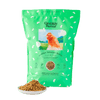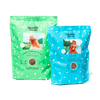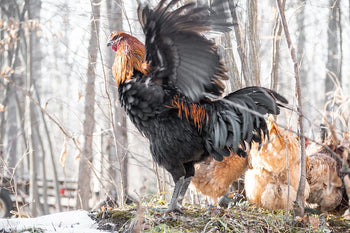When considering if chickens can fly, it is helpful to remember that just because a bird has feathers and wings does not necessarily mean it can fly. Think of the ostrich, for instance. They have wings but are too heavy to actually get off the ground and fly. Chickens are similar, as the breed and build of the chicken will influence its ability to fly. Let's find out what gives chickens the ability to fly and how that affects their lifestyle.

Can Chickens Fly? Yes, But Not Like Other Birds
Yes, chickens can fly. However, their flight is not the same as that of songbirds or raptors. Chickens do not need the ability to fly to survive. They do not hunt for prey from the air or need to build nests in trees. Chickens are ground nesters and foragers. These lifestyle features enabled chickens to survive without developing strong flying abilities.
The design of a chicken's wings is for short bursts of speed. They do not need to fly far, glide, or hover when flying. Not only are chickens' wings structured for short bursts of flight, but their muscles aren't developed enough to sustain long flights.
However, some chickens can fly better than others. A chicken's breed and age can affect its ability to fly. Young chickens still growing are not filled out and have yet to reach their adult weight. This allows them to fly better since their wings can catch enough air to lift their body weight. As a chicken matures and reaches its adult weight, it may not be able to fly as well due to a heavier body structure.
Large chicken breeds cannot fly as well as light or small chicken breeds. That is one reason large chickens, like Orpingtons and Cochins, are known to be friendly and calm. Light and small chicken breeds, like Anconas or Sebrights, are often known to be flighty and active because they have a better body structure for flying.
Chickens can fly vertically up better than sustaining a level, horizontal flight pattern. That means they can fly up to roosts 10 or 15 feet off the ground, but they may not be able to fly on a level plane for more than a foot or two. Some light chicken breeds can fly upwards of 30 feet high.
However, light chicken breeds can still achieve amazing flight records despite their limitations. The world record for a chicken's flight distance is 301.5 feet. Light-breed chickens can reach a flight speed of about 10 miles per hour and can easily fly up and over large structures or fences. Heavy chicken breeds rarely make it more than a foot or two off the ground.
Chickens don't just fly for fun. They are perfectly content to spend their day on the ground. Chickens purposely fly up to roosts at night for safety. It is instinctual for them to find a safe roosting place at night that does not leave them exposed to predators at ground level.
Likewise, since chickens are prey animals, they also fly when they are startled, scared, or attacked. While some chickens will attempt to fly up, heavier birds will simply use their wings as a way to propel them faster as they run. Chickens may also fly if they are excited to get food or treats. If a chicken encounters a fence or another obstacle, it may try to fly over the obstacle if it can't find a way around it. The flight ability of the chicken will dictate what obstacles it can fly over. Heavy chickens won't be able to scale a 5-foot fence, but a light chicken could easily fly over a 10-foot tall chicken coop.
The Evolutionary Perspective: Why Chickens Lost Their Ability to Fly
Our current-day chickens are all descendants of the jungle fowl. Wild jungle fowl live in sub-tropical and tropical areas around the world. These feral descendants of our chickens are small and active.
Since jungle fowl are small and light, they can fly for short distances. This attribute allows them to roost in tall trees at night for safety and to escape predators when they feel threatened. However, the jungle fowl does not need to fly for any other reason. Jungle fowl nest on the ground and forage for food on the ground, so long flights are unnecessary.
As selective breeding developed the many chicken breeds we have now, the chicken's ability to fly was altered. Chicken breeds genetically closest to their jungle fowl ancestors will be the best flyers. Chicken breeds further removed from their jungle roots will be less capable of flying.
Domestication and selective breeding diminished the chicken's need for flight as a way of survival. Heavy chicken breeds can't get enough lift to support their body weight in flight since their flight muscles are not strong enough, and their wings are not large enough to catch sufficient air. Chickens with woolly-like feathers (like Silkies) can't fly at all since their feathers lack the barbules and hooks that create a smooth feather vane for catching air.
Predator-proof coops, protective enclosures, and low roosts now enable our domestic chickens to survive and feel safe without being able to fly.

The Challenges of Keeping Flying Chickens in Urban and Suburban Areas
Since chickens can fly, and some light chicken breeds can fly very well, raising chickens in a non-rural setting can present some challenges. Some chickens will quickly scale fences meant to keep them safely in their designated yard. But there are still some ways to manage flighty birds even in an urban setting.
Fencing - The best way to keep chickens from flying in an urban setting is to provide plenty of space to move about without flying. Ensure their enclosure or run is covered if you don't want them escaping from their coop. For heavy chicken breeds, a fence that is at least 4-5 feet tall may suffice for keeping your flock contained. Flighty chicken breeds need a covered enclosure to keep them contained since they have no trouble flying over tall fences.
Roosting - To keep your birds from roosting in undesirable places, you will need to coop train your flock and ensure they have access to adequate roosts in the coop. Within the coop, block off tall perches you don't want your chickens roosting on at night. Possible areas include the rafter of the coop, windowsills, or any other structure in the coop that a chicken might attempt to roost on.
Make sure the roosts in the coop are inviting and safe. Allow enough roosting space for all the birds in your flock to roost at the same time, and have various roost heights if your flock is a mix of both heavy and light chicken breeds. The lighter chickens will appreciate higher roosts, while the heavier chickens will prefer the lower roosts.
Wing Trimming - Another option to discourage chickens from flying is to trim the flight feathers on a chicken's wing. While wing trimming does not hurt a chicken's wing, it can be painful if the feathers are trimmed wrong. Trimming the flight feathers on just one wing may disrupt even lift and prevent a chicken from being able to fly. Some determined chickens need the primary and secondary feathers on both wings trimmed to discourage flying.
Wing trimming is not a permanent fix to prevent flying. During the fall molt, the flight feathers will regrow and enable a chicken to fly again. Depending on how many feathers get trimmed, chickens with trimmed wings may need lower roosts since their ability to fly is compromised.

Conclusion
Chickens can fly, just not always in the same way some birds can. A chicken's breed and age determine its ability to fly. Young birds can fly better than older birds. Small, light chicken breeds can easily fly high and, in some cases, quite far since their wings can get sufficient lift to support their body weight in flight. Heavy chicken breeds are more grounded since their flight muscles are not strong enough to support their weight. No matter if your flock is grounded or if they are height-loving flyers, they will still provide endless hours of entertainment and enjoyment in their own special way!















